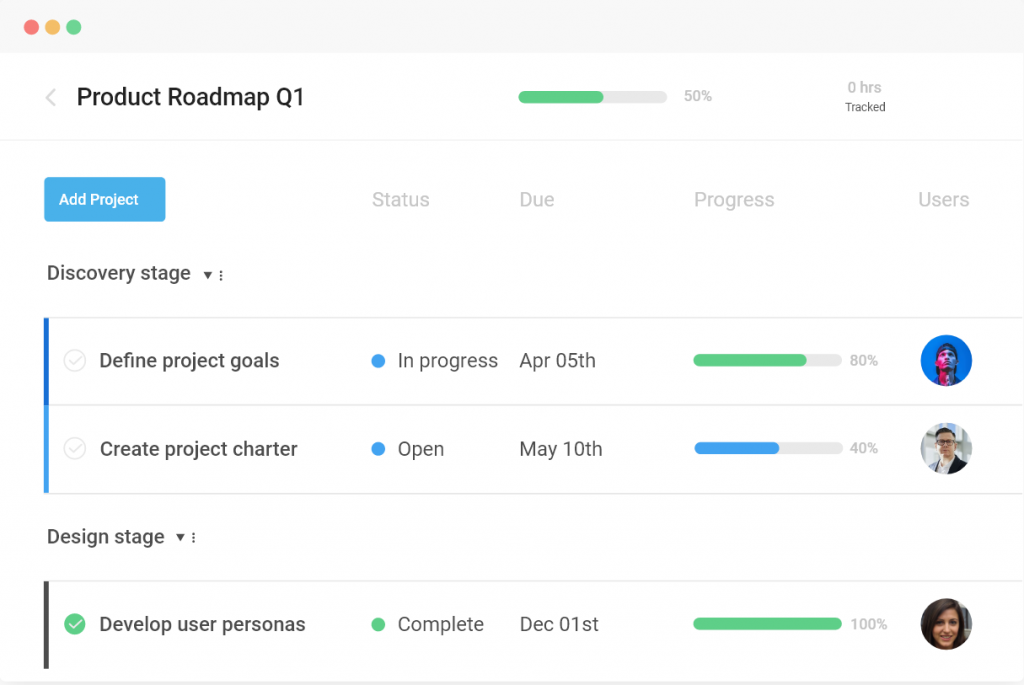In this thrilling project leadership journey, being a project leader is not just about managing; it’s about being a visionary.
You inspire, motivate, and enable your team to soar beyond limits. You strike a delicate balance of guidance and autonomy, creating an environment where ideas flow freely, and innovation knows no bounds. Also, challenges must be embraced and transformed into opportunities for growth and learning.
Wondering what’s the key to successful project leadership? It’s your unwavering belief in your team’s potential and your ability to blend it with a clear vision. When you trust your team, magic happens.
In this blog, we will explore what effective project leadership means for you, its benefits, responsibilities, and the essential skills required.
What Is Project Leadership?
Project leadership refers to motivating and coordinating a team to achieve project success. The leader unifies diverse talents, navigates challenges, and ensures each member contributes to achieving the desired outcome.
A great project leader possesses vision, communication skills, adaptability, and empathy, guiding a collaborative effort that brings the project’s goals to life.
Good leaders set clear goals, communicate effectively, and make strategic decisions. They foster a positive and productive work environment, encourage collaboration, and support individual growth.
Simply put, they lead by example, inspire their team, and ensure the company’s vision is achieved through effective management and strong leadership skills.
Now let’s dig a little deeper into the importance of leadership in project management.
Importance of Leadership in Project Management

Here are the benefits of effective project leadership in the workplace.
Inspiration & Vision
Leaders provide the vision that fuels the project’s purpose, motivating team members to strive for excellence. By setting clear objectives and defining the project’s mission, leaders steer the course and keep everyone aligned.
For instance, Steve Jobs’ visionary leadership at Apple led to groundbreaking innovations like the iPhone, transforming the tech industry.
Team Motivation & Empowerment
Effective leaders inspire and empower their teams, creating an environment of trust and camaraderie. A leader who nurtures collaboration and celebrates individual strengths ensures that the team works in unison towards the shared business goals.
A shining example is Sir Alex Ferguson, who transformed Manchester United into a football dynasty through his motivational leadership.
Conflict Resolution
Effective leaders adeptly navigate project conflicts, fostering open communication and cooperation among team members. They prioritize addressing conflicts promptly and transparently, encouraging a safe environment for dialogue.
By leading by example and embracing conflicts as opportunities for growth, they create a pleasant and productive work atmosphere, ensuring the successful realization of shared goals.
Decision-Making & Risk-Taking
Exceptional leaders exhibit their prowess by making decisive choices, embracing calculated risks to propel the project forward with confidence and determination.
They carefully analyze potential outcomes, leveraging their expertise and intuition to assess risks effectively. When they show courage in their decision-making, they inspire their team to trust their leadership and lead remarkable achievements.
For example, Elon Musk’s bold decision to invest in electric cars and space exploration exemplifies the impact of visionary risk-taking.
Adaptability & Resilience
Outstanding leaders demonstrate their ability to navigate through uncertainties and setbacks with unwavering composure. They embrace the unknown with a forward-thinking mindset, turning obstacles into opportunities for growth.
By staying agile, they inspire their team to persevere and overcome obstacles, ultimately achieving success even in the most demanding circumstances.
Communication & Transparency
Effective communication is a hallmark of successful leaders, ensuring clarity, unity, and transparency within the project team. Their adept communication skills empower them to convey their vision with precision, fostering a shared understanding among team members.
Through transparent and open dialogue, they create an inclusive and collaborative environment, enabling the team to work cohesively towards shared goals. For instance, Indra Nooyi’s transparent leadership style at PepsiCo fostered a culture of open dialogue and innovation.
Stakeholder Management
Leaders build strong relationships with stakeholders, addressing their concerns and aligning their interests with project objectives. Their interpersonal skills enable them to empathetically understand the needs and expectations of stakeholders, fostering a sense of trust and cooperation.
By consistently engaging with stakeholders, they ensure a mutually beneficial partnership, contributing significantly to the project’s overall success.
Crisis Management
Leaders excel at crisis management, leading teams through turbulent times with composure and strategic thinking. Their ability to stay calm under pressure inspires confidence in the team and stakeholders alike.
With a clear focus on the bigger picture, they make well-informed decisions that mitigate risks and position the project for a strong recovery.
During the 2008 global financial crisis, Apple Inc.’s CEO, Tim Cook, showcased exceptional crisis management.
Despite market uncertainties, he maintained a clear long-term vision and took decisive actions, like streamlining operations and optimizing supply chains, which ensured Apple’s stability. Under his leadership, the company not only survived but thrived, setting it up for a robust recovery and sustained success in the subsequent years.
Now that you understand the importance of project leadership, let’s now explore the intriguing question: how does project leadership differ from project management?
What Is the Difference Between Project Leadership & Management?
Project leadership and management are quite different from each other. Project leaders share their inputs regarding planning, keep a tab on the task execution, offer emotional support to the team during tough times, etc. They report to the project manager regarding achieved milestones, budget utilization, resource allocation, etc.
Project managers, on the other hand, work on factors like strategies, feature prioritization, deadlines, budget, etc. They communicate with clients and take care of documentation, staffing, HR concerns (in some cases), etc.
Note that a project leader can act as a manager, but the latter cannot exchange job responsibilities with the former.
Here is a straightforward table to highlight the differences between project leaders and project managers.
Aspect
Project Leadership
Project Management
Vision & Strategy
Casts the Vision: Leaders envision the future, steer the course, and inspire the team to reach new horizons.
Implements Strategy: Managers focus on executing the defined strategy, breaking it into actionable tasks.
Driving Innovation
Fosters Creativity: Leaders encourage innovation, thinking outside the box, and embracing calculated risks.
Ensures Efficiency: Managers prioritize processes, resources, and timelines to optimize productivity.
Dealing with People
Empowering & Influencing: Leaders motivate and empower team members, fostering trust and mutual collaboration.
Organizing & Coordinating: Managers handle resource allocation, task assignments, and coordinate efforts to achieve collective goals.
Handling Challenges
Resilient Problem-Solvers: Leaders adapt to unforeseen challenges, learn from failures, and guide the team toward solutions.
Mitigates Risks: Managers anticipate potential pitfalls, establish contingency plans, and monitor project health.
Communication Style
Inspirational Communicators: Leaders use storytelling, empathy, and active listening to communicate purpose and vision.
Clear & Direct Communicators: Managers employ concise, factual communication to ensure understanding and direction.
Time Perspective
Long-term Focus: Leaders keep an eye on the big picture, recognizing the project’s broader impact and future possibilities.
Short-term Focus: Managers concentrate on immediate objectives, meeting deadlines, and staying on track.
Decision-making
Decisive Visionaries: Leaders make bold decisions, often based on intuition, and take responsibility for outcomes.
Analytical Decision-makers: Managers use data and analysis to make informed choices, minimizing risks.
Personal Traits
Charismatic & Inspiring: Leaders exude charisma, emotional intelligence, and a passion for driving change.
Organized & Detail-Oriented: Managers exhibit strong organizational skills, attention to detail, and a focus on execution.
By now, you have understood the core differences between a project leader and a manager.
Do you know the 5 core responsibilities that project leadership involves? Let’s check them out next!
5 Core Responsibilities of a Project Leader
Here are the key responsibilities of a project leader while managing projects.
1. Planning Project Timelines & Deliverables
One of the key project leadership roles is planning project timelines and deliverables.
As a project leader, you get to play the role of a master architect, carefully laying out the blueprints for the project’s success. But let’s be honest, even the best-laid plans can go off track, so you need to be both a visionary and a problem-solver.
The journey to achieving those desired outcomes begins with breaking down the project into manageable phases and tasks.
First, gather your team and brainstorm together. Listen to their ideas and insights – a good leader knows that the best solutions often come from collective wisdom. Once you have a solid understanding of the project’s scope and objectives, it’s time to set realistic timelines and establish clear deliverables. Remember, you want your team to feel motivated, not overwhelmed, so striking the right balance is essential.
Here, using a robust project management tool comes in handy. It lets you create project dashboards that help convey scheduled tasks and their timelines to everyone involved.
Let’s take the example of ProProfs Project to see what a project dashboard looks like.

2. Assigning Tasks & Responsibilities to Team Members
Now that we have our well-crafted project plan, it’s time to put our leadership skills to work in task assignments! Think of yourself as a matchmaker, finding the perfect pairing of tasks and team members.
You need to understand each team member’s strengths, weaknesses, and interests. This way, you’ll ensure the right people are handling the right tasks, increasing efficiency, and fostering a sense of ownership and enthusiasm.
But, hold on. Assigning tasks is not a one-and-done deal. It’s an ongoing process that requires open communication. Be approachable and let your team members know they can always discuss their roles and responsibilities with you. As the project progresses, be ready to adapt and reallocate tasks if necessary.
Utilize a tool to assign clear timelines and delegate tasks to team members. Additionally, prioritize tasks to ensure that urgent ones receive immediate attention.
3. Monitoring Project Progress & Ensuring Adherence to Goals
Being a project leader, you are responsible for steering the project toward its destination. But how do you ensure the project stays on course? With real-time!
Keeping a keen eye on the project’s progress is crucial. Embrace technology and use project management tools to track milestones, deadlines, and project KPIs (Key Performance Indicators). This data will be your guiding star when making informed decisions.
Leverage Gantt, Kanban and other project views to monitor progress and identify areas where adjustments may be needed.
For example, with Gantt charts, you can easily track overlapping tasks and avoid allocating the same resource to conflicting assignments. This streamlines work and prevents excessive workloads, ensuring smoother project execution.

Of course, it’s not all about crunching numbers and reviewing charts. You also need to communicate regularly with your team – not just about deadlines and metrics, but about their experiences, too.
Listen to their challenges, celebrate their successes, and provide support when needed. A leader who shows genuine care and interest in their team members’ well-being is more likely to steer the project to victory.
Again, you can use a tool to exchange ideas and collaborate on projects via task comments.
4. Managing Project Risks & Resolving Issues
Risk in project management is unavoidable. Among the crucial project leadership roles is managing risks and resolving them timely.
As the project leader, you must be armed with the right tools and strategies to fend off this pesky foe.
First, conduct a risk assessment with your team. Identify potential stumbling blocks and develop contingency plans. Be proactive, not reactive.
When risks arise, take a deep breath, gather your team’s superpowers, and face them head-on. A positive attitude and a calm demeanor will inspire confidence in your team.
Remember, problem-solving is a collective effort, so encourage open discussions and brainstorming sessions. The goal is not just to overcome obstacles but to learn from them, making your team even stronger in the process.
With the right tool, you can gain access to data-driven reports on project profitability, comments, and overall summary. This helps gain insight into KPIs, helping you make informed decisions.

5. Communicating With Stakeholders & Reporting Project Status
You’re nearing the completion of your project – congratulations, you’ve come a long way!
But before you can bask in the glory of success, you must engage in one final quest: communicating with stakeholders. Project leadership involves narrating the project’s journey, highlighting the challenges, triumphs, and overall impact.
Be transparent and honest in your communication. Keep stakeholders informed about progress, setbacks, and any changes to the project’s direction. When delivering updates, remember that not everyone speaks the language of project management fluently, so break down complex jargon into easily digestible insights.
As you share the story of your project, give credit where it’s due. Acknowledge the hard work and dedication of your team members. And don’t forget to celebrate the project’s successful conclusion.
It’s now time to familiarize yourself with the 6 essential skills for project leadership!
6 Essential Skills for Project Leadership

Take a look at the key project leadership skills in project management.
- Essential Skills for Project Leaders: These skills are crucial because they form the foundation of effective project leadership. By mastering them, project leaders can create a positive and productive work culture that empowers the team to achieve their goals efficiently.
- Communication and Interpersonal Skills: Effective communication ensures that everyone on the team is on the same page, understands their roles, and receives clear instructions. Interpersonal skills help in building trust and fostering strong working relationships, which are essential for collaboration and teamwork.
- Decision-Making and Problem-Solving Abilities: Project leaders face various challenges and obstacles throughout a project’s lifecycle. Being skilled in decision-making and problem-solving allows them to make timely and informed choices, resolve issues, and keep the project moving forward.
- Emotional Intelligence and Empathy: Understanding team members’ emotions and perspectives helps project leaders provide the necessary support, motivation, and encouragement. Empathy enables them to address concerns, boost morale, and create a positive work atmosphere that enhances productivity.
- Adaptability and Flexibility: Projects rarely go exactly as planned. Adaptability and flexibility is one of the key project leadership skills that allow project leaders to respond to unexpected changes, adjust timelines, and make necessary revisions without losing focus on the project’s end goal.
- Visionary and Strategic Thinking: Having a clear vision and thinking strategically helps project leaders set a direction for the project, align the team’s efforts, and make informed decisions that lead to desired outcomes. This skill ensures that the team stays focused and works towards a shared purpose.
So you’re familiar with the skills now. But do you know that understanding the unique demands of each industry is crucial for successful project management?
Let’s understand how.
Project Leadership Across Various Industries
Project leadership is a critical aspect of successful project management across all industries. However, the specific skills, challenges, and approaches required by project leaders can vary significantly depending on the industry they operate in.
This section explores the differences in project leadership across various industries and highlights how adaptability and specialized knowledge play pivotal roles in achieving project success.
Construction Industry
Project leadership in the construction industry demands a deep understanding of architectural design, engineering principles, and regulatory requirements.
Leaders must coordinate large teams of architects, engineers, contractors, and laborers, while also managing tight timelines and budgets. Risk management and safety protocols are paramount due to the potential for physical harm and financial losses.
Information Technology (IT) Industry
In the fast-paced world of IT, project leaders face ever-changing technologies, evolving customer demands, and rapidly shifting market dynamics.
These leaders must possess a strong technical background, as well as the ability to foster innovation and manage cross-functional teams. Agile methodologies are often preferred to respond quickly to changing requirements.
Healthcare Industry
In the healthcare sector, project leadership requires a unique blend of medical knowledge, administrative expertise, and interpersonal skills.
Leaders collaborate with medical professionals, administrators, and stakeholders to implement new systems, improve patient care, and ensure compliance with strict regulations, such as HIPAA (Health Insurance Portability and Accountability Act).
Creative Industry
Project leaders in marketing and advertising need to be creative visionaries who can translate client objectives into compelling campaigns.
They work with designers, copywriters, and marketing specialists, and must adapt quickly to dynamic market trends. Here, effective communication and negotiation skills are essential for managing client expectations and delivering successful projects.
Renewable Energy Industry
Project leadership in renewable energy focuses on sustainable solutions and environmental impact.
Leaders in this industry navigate regulatory frameworks, conduct site assessments, and manage multi-disciplinary teams. They must anticipate logistical challenges and economic considerations to ensure the successful implementation of renewable energy projects.
Steer Your Team to Success as a Project Leader!
This blog covered the secrets to success with effective project leadership. A project leader inspires, strategizes, and communicates effectively, recognizing the value of their team’s growth.
By blending managerial skills with visionary thinking, they navigate challenges with adaptability.
Remember to tailor your approaches to fit the intricacies of each sector while maintaining a focus on achieving project objectives and delivering exceptional results.
Now, it’s time to embrace your leadership potential, leave behind an inspiring legacy and lead your projects to success!
Frequently Asked Questions
Is a project manager a leader?
Of course, project managers possess leadership qualities, as they handle both parties (clients and teams). But project managers usually have too much on their plate, and that’s why a person gets hired for the designation of a project leader for smooth operations and team handling.
What is the difference between a project manager and a project leader?
A project manager takes care of many aspects like client requirements, staffing, deadlines, budget, etc. On the other hand, a project leader makes sure that tasks are executed as per the plan and keeps an eye on the performance of team members.
FREE. All Features. FOREVER!
Try our Forever FREE account with all premium features!





